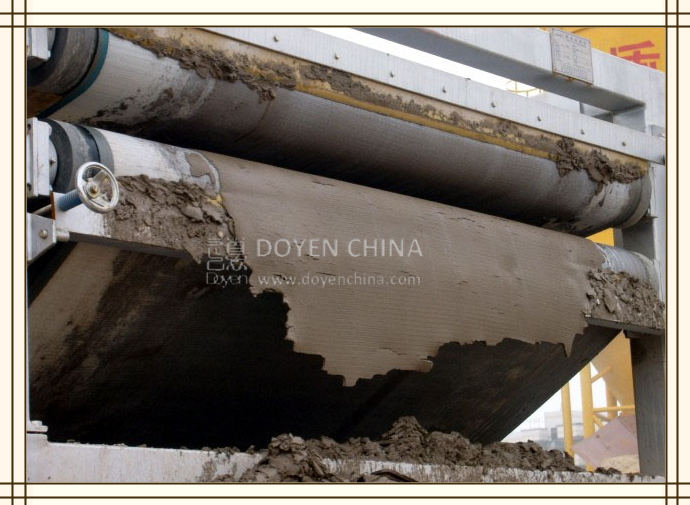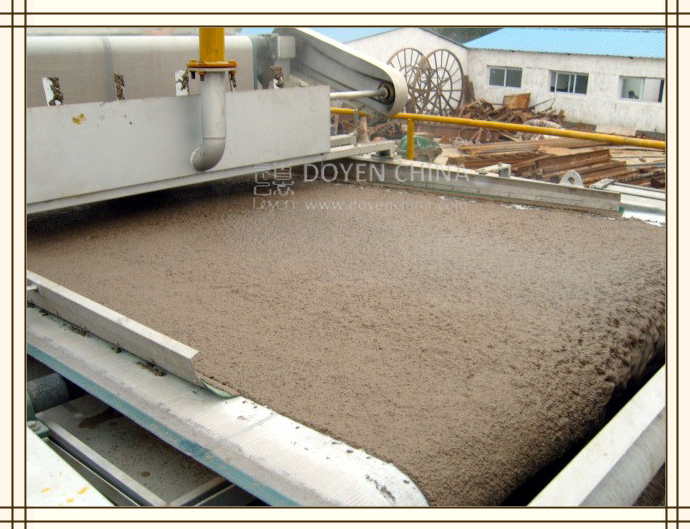

Tel:
+86-757-8633-0278
Email:doyen@doyenchina.com
Fax:+86-757-86287390
Address:Room 201, Building No. 24, Yicui Rose Garden, No. 2, Jihua 7 Road, Chancheng District, Foshan City, Guangdong Province, China 528000.
The belt filter press produced by doyenchina has been put into operation in a number of large and medium-sized printing and dyeing plants, dyeing and finishing plants in Southeast Asia and the centralized treatment center for printing and dyeing wastewater in cities, with good results and favorable comments from customers. For example, a large printing and dyeing plant in Foshan (we can take you to the customer’s sewage treatment site for inspection) selects a filter press with a bandwidth of 2 meters from our plant, and the filter cake produced by the filter press during operation is relatively small It is compact and flaky, with very low moisture content. The operator can directly load (dump truck) without bagging and transport it to the brickmaking plant for waste utilization. As a result, the 1000 square meter drying yard which has been used for many years has been abandoned and the air has been purified, which has been affirmed by the environmental protection department. At the end of 2012, the factory ordered another equipment from us because of the increase of production.

The belt filter press is an important link in the sludge dewatering of printing and dyeing wastewater treatment. The working conditions of the belt filter press in the sludge dewatering of printing and dyeing industry, such as the moisture content of filter cake, hourly treatment capacity and trouble free working time, have a lot to do with the technology and materials of the belt filter press itself. The actual filter press effect is also related to whether the whole set of printing and dyeing wastewater treatment process is sufficient and flocculation There is a certain relationship between the choice of agents. Guangzhou Meibang environmental protection machinery Co., Ltd. has the experience of cooperation with dozens of large and medium-sized printing and dyeing plants. We are willing to work with you to work out a more scientific dehydration treatment scheme of printing and dyeing sludge according to the actual situation of your sewage treatment. Welcome to visit our company’s manufacturing workshop, and visit our existing dyeing, dyeing and finishing, washing water and other customers’ sludge dewatering project site.
Printing and dyeing wastewater consists of auxiliaries, dyestuffs, size and so on discharged from dyeing and finishing process. The dyestuffs discharged cause the color of printing and dyeing wastewater. About 10% – 20% of dyestuffs are discharged along with the wastewater in the process of printing and dyeing. The dyestuffs in the wastewater can absorb light, reduce the transparency of water body, affect aquatic organisms and microorganisms, and are not conducive to self purification of water body, and cause visual pollution at the same time Seriously, it will affect human health. Printing and dyeing wastewater is one of the industrial wastewater which is difficult to be treated because of its large amount of water, high concentration of organic pollutants, deep chroma, large alkalinity, large change of water quality and complex composition. With the continuous renewal of dyeing and finishing processes, some of them lead to the complexity of printing and dyeing wastewater treatment.
At present, the wastewater discharge of textile printing and dyeing industry ranks the fifth in the national industrial wastewater discharge, and the COD discharge ranks the fourth.

Especially in recent years, the increase of export volume has stimulated the sharp increase of domestic textile production, and the amount of wastewater generated in the dyeing and finishing process is very large, generally up to 70% – 90% of the water consumption of printing and dyeing enterprises. At present, 4-5 tons of wastewater are produced per 100 meters of cloth dyeing in China. According to incomplete statistics, the daily discharge of printing and dyeing wastewater in China has exceeded 4 million m3. Therefore, it is very urgent to treat the “three wastes”, especially the waste water, which are discharged in the production process of domestic printing and dyeing industry. Welcome to joyce@doyenchina.com or visit https://www.doyenchina.com.
Jan-28-2020
admin

 +86-757-8633-0278
+86-757-8633-0278 doyen@doyenchina.com
doyen@doyenchina.com Sitemap
Sitemap